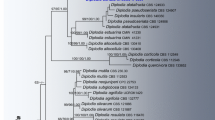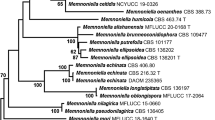Abstract
A new species of Shackletonia (Teloschistaceae) is described from the McMurdo Dry Valleys in Antarctica, one of the regions with the harshest conditions on Earth. Distinctive traits of the new taxon are the grey thallus, its black lecideine apothecia with a dark greenish blue exterior side of the exciple, Lecidea green pigment present at the cortex and exciple, emodin-dominated anthraquinones only in epithecium, and spores on average 11.2 × 6.0 μm with 3.6 μm wide septum. New chemical data from HPLC analyses further supports the uniqueness of the genus Shackletonia regarding secondary metabolite production within subfamily Xanthorioideae. Using three molecular markers (nrITS, nuLSU, and mtSSU) we found the new species sister to S. sauronii, a species so far known only from Livingston Island (Antarctica). Using secondary calibrations we inferred a long-time evolution of Shackletonia in the Southern Hemisphere, which separated from the remaining lineages of Xanthorioideae between the late Cretaceous and the early Paleogene, and diversified during the late Paleocene and early Oligocene.




Similar content being viewed by others
References
Amo de Paz G, Cubas P, Divakar PK, Lumbsch HT, Crespo A (2011) Origin and diversification of major clades in parmelioid lichens (Parmeliaceae, Ascomycota) during the Paleogene inferred by Bayesian analysis. Plos One 6:e28161
Arup U, Søchting U, Frödén P (2013) A new taxonomy of Teloschistaceae. Nord J Bot 31:16–83
Bachmann E (1890) Ueber nichtkrystalliserte Flechtenfarbstoff, ein Beitrag zur Chemie und Anatomie der Flechten. Jahrb Wiss Bot 21:1–61
Birkenmajer K, Gaździcki A, Krajewski KP, Przybycin A, Solecki A, Tatur A, Yoon HI (2005) First Cenozoic glaciers in West Antarctica. Pol Polar Res 26:3–12
Castresana J (2000) Selection of conserved blocks from multiple alignments for their use in phylogenetic analysis. Mol Biol Evol 17:540–552
Convey P, Gibson JAE, Hillenbrand CD, Hodgson DA, Pugh PJA, Smellie JL, Stevens MI (2008) Antarctic terrestrial life—challenging the history of the frozen continent? Biol Rev 83:103–117
Cubero OF, Crespo A, Fatehi J, Bridge PD (1999) DNA extraction and PCR amplification method suitable for fresh, herbarium-stored, lichenized, and other fungi. Plant Syst Evol 216:243–249
Darriba D, Taboada GL, Doallo R, Posada D (2012) jModelTest 2: more models, new heuristics and parallel computing. Nat Methods 9:772
Divakar PK, Crespo A, Wedin M, Leavitt SD, Hawksworth DL, Myllys L, McCune B et al (2015) Evolution of complex symbiotic relationships in a morphologically derived family of lichen-forming fungi. New Phytol 208:1217–1226
Drummond A, Ho S, Phillips M, Rambaut A (2006) Relaxed phylogenetics and dating with confidence. Plos Biol 4:e88
Drummond AJ, Suchard MA, Xie D, Rambaut A (2012) Bayesian phylogenetics with BEAUti and the BEAST 1.7. Mol Biol Evol 29:1969–1973
Francis JE, Ashworth A, Cantrill DJ, Crame JA, Howe J, Stephens R, Tosolini AM, Thorn V (2008) 100 million years of Antarctic climate evolution: evidence from fossil plants. In: Cooper AK, Barrett PJ, Stagg H, Storey B, Stump E, Wise W (eds) Antarctica: a keystone in a changing world. Proceedings of the 10th International Symposium on Antarctic Earth Sciences. The National Academies Press, Washington, pp 19–27
Gaya E, Fernández-Brime S, Vargas R, Lachlan RF, Gueidan C, Ramírez-Mejía M, Lutzoni F (2015) The adaptive radiation of lichen-forming Teloschistaceae is associated with sunscreening pigments and a bark-to-rock substrate shift. Proc Natl Acad Sci U S A 112:11600–11605
Grube M (2010) Die hard: lichens. In: Seckbach J, Grube M (eds) Symbioses and stress: joint ventures in biology (Cellular origin, life in extreme habitats and astrobiology), vol 17. Springer, Dordrecht, pp 509–523
Guindon S, Dufayard JF, Lefort V, Anisimova M, Hordijk W, Gascuel O (2010) New algorithms and methods to estimate maximum-likelihood phylogenies: assessing the performance of PhyML 3.0. Syst Biol 59:307–321
Hall TA (1999) BioEdit: a user-friendly biological sequence alignment editor and analysis program for Windows 95/98/NT. Nucl Acid Symp 41:95–98
Hansen ES, Poelt J, Søchting U (1987) Die Flechtengattung Caloplaca in Grönland. Meddr Grønland Biosci 25:1–52
Kappen L (1982) Lichen oases in hot and cold deserts. J Hattori Bot Lab 53:325–330
Kappen L (2000) Some aspects of the great success of lichens in Antarctica. Antarct Sci 12:314–324
Katoh K, Standley DM (2013) MAFFT Multiple sequence alignment software version 7: improvements in performance and usability. Mol Biol Evol 30:772–780
Katoh K, Toh H (2008) Recent developments in the MAFFT multiple sequence alignment program. Brief Bioinform 9:286–298
Katoh K, Misawa K, Kuma KI, Miyata T (2002) MAFFT: a novel method for rapid multiple sequence alignment based on fast fourier transform. Nucl Acids Res 30:3059–3066
Leavitt SD, Esslinger TL, Divakar PK, Lumbsch HT (2012) Miocene and Pliocene dominated diversification of the lichen-forming fungal genus Melanohalea (Parmeliaceae, Ascomycota) and Pleistocene population expansions. BMC Evol Biol 12:176
Leavitt SD, Divakar PK, Ohmura Y, Li-song W, Esslinger TL, Lumbsch HT (2015) Who’s getting around? Assessing species diversity and phylogeography in the widely distributed lichen-forming fungal genus Montanelia (Parmeliaceae, Ascomycota). Mol Phylogenet Evol 90:85–96
Librado P, Rozas J (2009) DnaSP v5: a software for comprehensive analysis of DNA polymorphism data. Bioinformatics 25:1451–1452
Mason-Gamer RJ, Kellogg EA (1996) Testing for phylogenetic conflict among molecular data sets in the tribe Triticeae (Gramineae). Syst Biol 45:524–545
Miller KG, Kominz MA, Browning JV, Wright JD, Mountain GS, Katz ME, Sugarman PJ, Cramer BS, Christie-Blick N, Pekar SF (2005) The Phanerozoic record of global sea-level change. Science 310:1293–1298
Miller MA, Pfeiffer W, Schwartz T (2010) Creating the CIPRES science gateway for inference of large phylogenetic trees. In: Proceedings of the Gateway Computing Environments Workshop (GCE): 1–8. New Orleans
Olech M, Søcthing U (1993) Four new species of Caloplaca from Antarctica. Lichenologists 25:261–269
Øvstedal DO, Smith RIL (2001) Lichens of Antarctica and South Georgia. A guide to their identification and ecology. Cambridge University Press, Cambridge
Peat HJ, Clarke A, Convey P (2007) Diversity and biogeography of the Antarctic flora. J Biogeogr 34:132–146
Pérez-Ortega S, Fernández-Mendoza F, Raggio J, Vivas M, Ascaso C, Sancho LG, Printzen C, De los Ríos A (2012a) Extreme phenotypic variation in Cetraria aculeata (lichenized Ascomycota): adaptation or incidental modification? Ann Bot 109:1133–1148
Pérez-Ortega S, Ortiz-Álvarez R, Green TGA, De los Ríos A (2012b) Lichen myco- and photobiont diversity and their relationships at the edge of life (McMurdo Dry Valleys, Antarctica). FEMS Microbiol Ecol 82:429–448
Poelt J, Pelleter U (1984) Zwergstrauchige Arten der Flechtengattung Caloplaca. Plant Syst Evol 148:51–88
Ronquist F, Teslenko M, van der Mark P, Ayres DL, Darling A, Höhna S, Larget B, Liu L, Suchard MA, Huelsenbeck JP (2012) MrBayes 3.2: efficient Bayesian phylogenetic inference and model choice across a large model space. Syst Biol 61:539–542
Ruprecht U, Brunauer G, Printzen C (2012) Genetic diversity of photobionts in Antarctic lecideoid lichens from an ecological view point. Lichenologist 44:661–678
Søchting U (1989) Lignicolous species of the lichen genus Caloplaca from Svalbard. Oper Bot 100:241–257
Søchting U, Olech M (1995) The lichen genus Caloplaca in polar regions. 27:463–471
Søchting U (1997) Two major anthraquinone chemosyndromes in Teloschistaceae. Bibl Lichenologica 68:135–144
Søchting U, Seppelt R (2003) Caloplaca coeruleofrigida sp. nova, a lichen from Continental Antarctica. Mycotaxon 86:163–168
Søchting U, Øvstedal DO, Sancho LG (2004) The lichens of Hurd Peninsula, Livingston Island, South Shetlands, Antarctica. Bibl Lichenologica 88:607–658
Søchting U, Lorentsen LB, Arup U (2008) The lichen genus Caloplaca (Ascomycota, Lecanoromycetes) on Svalbard. Notes and additions. Nova Hedwigia 87:69–96
Søchting U, Søgaard MZ, Elix JA, Arup U, Elvebakk A, Sancho LG (2014a) Catenarina (Teloschistaceae, Ascomycota), a new Southern Hemisphere genus with 7-chlorocatenarin. Lichenologist 46:175–187
Søchting U, Garrido-Benavent I, Seppelt R, Castello M, Pérez-Ortega S, De los Ríos A, Sancho LG, Frödén P, Arup U (2014b) Charcotiana and Amundsenia, two new genera in Teloschistaceae (lichenized Ascomycota, subfamily Xanthorioideae) hosting two new species from continental Antarctica, and Austroplaca frigida, a new name for a continental Antarctic species. Lichenologist 46:763–782
Sojo F, Valladares F, Sancho LG (1997) Structural and physiological plasticity of the lichen Catillaria corymbosa in different microhabitats of the maritime Antarctica. Bryologist 100:171–179
Suchard MA, Rambaut A (2009) Many-core algorithms for statistical phylogenetics. Bioinformatics 25:1370–1376
Sudgen DE, Bentley MJ, Cofaigh Ó (2006) Geological and geomorphological insights into Antarctic ice sheet evolution. Philos Trans R Soc A 364:1607–1625
Tamura K, Peterson D, Peterson N, Stecher G, Nei M, Kumar S (2011) MEGA5: molecular evolutionary genetics analysis using maximum likelihood, evolutionary distance and maximum parsimony methods. Mol Biol Evol 28:2731–2739
Valladares F, Sancho LG, Ascaso C (1998) Water storage in the lichen family Umbilicariaceae. Bot Acta 111:99–107
Vilgalys R, Hester M (1990) Rapid genetic identification and mapping of enzymatically amplified ribosomal DNA from several Cryptococcus species. J Bacteriol 172:4238–4246
Villesen P (2007) FaBox: an online toolbox for fasta sequences. Mol Ecol Notes 7:965–968
Wetmore CM (1996) The Caloplaca sideritis group in North and Central America. Bryologist 99:292–314
Wirtz N, Printzen C, Lumbsch HT (2008) The delimitation of Antarctic and bipolar species of neuropogonoid Usnea (Ascomycota, Lecanorales): a cohesion approach of species recognition for the Usnea perpusilla complex. Mycol Res 112:472–484
Zachos J, Pagani M, Sloan L, Thomas E, Billups K (2001) Trends, rhythms, and aberrations in global climate 65 Ma to present. Science 292:686–693
Zhou S, Stanosz GR (2001) Primers for amplification of mtSSU rDNA, and a phylogenetic study of Botryosphaeria and associated anamorphic fungi. Mycol Res 105:1033–1044
Zoller S, Scheidegger S, Sperisen C (1999) PCR primers for the amplification of mitochondrial small subunit ribosomal DNA of lichen-forming ascomycetes. Lichenologist 31:511–516
Acknowledgments
This work was made possible due to a SYNTHESYS scholarship, which is financed by the European Community Research Infrastructure Action (http://www.synthesys.info/), to the University of Copenhagen (DK-TAF-3064) to the first author. The study was also supported by the Spanish Economy and Competitiveness Ministry grants CTM2012-38222-C02-02 and FPU AP2012-3556. SPO is supported by the grant RYC-2014-16784 from the Spanish Economy and Competitiveness Ministry. We are also grateful to T.G.A. Green, the New Zealand Antarctic Program, and the University of Waikato Antarctic Research Program by arranging and funding the expedition to Dry Valleys in which lichen samples were collected.
Author information
Authors and Affiliations
Corresponding author
Additional information
Section Editor: Gerhard Rambold
Electronic supplementary material
Below is the link to the electronic supplementary material.
ESM 1
(PDF 181 kb)
Rights and permissions
About this article
Cite this article
Garrido-Benavent, I., Søchting, U., de los Ríos Murillo, A. et al. Shackletonia cryodesertorum (Teloschistaceae, Ascomycota), a new species from the McMurdo Dry Valleys (Antarctica) with notes on the biogeography of the genus Shackletonia . Mycol Progress 15, 743–754 (2016). https://doi.org/10.1007/s11557-016-1204-x
Received:
Revised:
Accepted:
Published:
Issue Date:
DOI: https://doi.org/10.1007/s11557-016-1204-x




